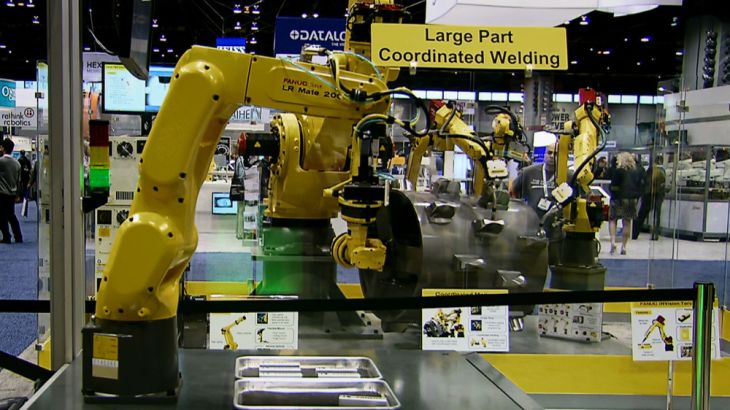
The Tech Threat – part two
As automation gets cheaper than the cost of labour, developing economies are being hit the hardest.
This is the second of a two-part special report from People & Power’s Bob Abeshouse. Watch part one here.
By Bob Abeshouse
Keep reading
list of 4 items‘Triple spending’: Zimbabweans bear cost of changing to new ZiG currency
Boeing hit with 32 whistleblower claims, as dead worker’s case reviewed
US imposes new sanctions on Iran after attack on Israel
Robotics has been used in manufacturing for decades. But advances in sensors and machine learning software are rapidly expanding their use, especially in industry. A new generation of robots is emerging that can work alongside humans and replace them in ways never seen before.
Some of the most innovative robotics technology for industry was on display at the Automate 2015 expo in Chicago earlier this year. Wynright, a US company that provides material handling and distribution systems, showcased its Robotic Truck Unloader that landed it on the list of the top 50 robotics companies to watch.
Wynright’s robot autonomously moves in and out of trucks to load and unload shipments, arranging different products by box size. The robot can send different products in a truck to distinct locations in a warehouse, or prepare an order for shipment that includes varied products.
According to Wynright CEO Kevin Ambrose, the functions performed by the robot all required a human in the past. But he argues it is not a threat to jobs. The unloader displaces manual workers, Ambrose says, but creates the need for employees with “another skills set. So we train those operators to now elevate up into that skill set level, to be more of a technician as opposed to just a pure labourer.”
The skills manufacturing workers need to hold onto jobs are also changing as a result of advances in robotic sensors and software. They have given rise to a new type of collaborative robot that can work alongside people doing a wide range of tasks, instead of being isolated in cages for human safety.
The Danish company Universal Robots unveiled their newest collaborative robot, the UR3, at the Chicago expo. Universal, a leading collaborative robot manufacturer, sells several models for different tasks. Their cost ranges from between $23,000 to $45,000, a price that is attractive to small and medium-sized companies. The days when only large-scale manufacturers could invest in robotics to replace workers are fading fast. Universal’s CEO Enrico Krog Iverson says, “You end up with a payback time of somewhere between three to nine months and of course that is very, very beneficial for all manufacturing industries.”
![Enrico Krog Iverson is CEO of Danish company Universal Robots, which makes collaborative robots, sold at a price attractive to small and medium-sized companies [Al Jazeera]](/wp-content/uploads/2015/06/2e56ea524c5a4845b7cf7547f1eedd37_18.jpeg)
Advances in software that make collaborative robots easy to programme also make them attractive. Until recently, the use of a robot for production required a skilled programmer to control its movements. You can direct a Universal robot by simply positioning the arm and pressing a button. “You’re up and running in less than an hour from when you receive your boxes,” says Iverson.
Universal is targeting manufacturers of consumer electronics, computers and small household appliances in North America and has an office in China. Advances in robotics technology, and drops in its cost, are driving a surge of investment in robots around the world. Last year, the worldwide supply of robots increased by 27 percent. Sixty percent of the growth was in Asia.
Hal Sirkin, a senior partner at the Boston Consulting Group in Chicago, issued a report recently that projected a 25 percent increase in the use of robotics for manufacturing in the next ten years, leading to a 16 percent decrease in labour costs. “What we’re seeing now is the cost of robotics is becoming in many industries cheaper than the cost of the labour,” he says. He projects that “in the next ten years we’ll see about a doubling in the amount of robotics that are being used in factories in the US and around the world.” In some countries, according to his study, it’s going to be even higher than that.
The biggest market for robotics today is in China, resulting primarily from a steep rise in labour costs of as much as 17 percent a year, Sirkin says. He argues that in the future cheap labour costs will be much less important in determining the location of global manufacturing. “When you get to a reasonable steady state in the robotics level what will happen is everybody will have essentially the same cost and therefore people will start to localise,” he says. “You won’t have the ability to have these twenty-five percent cost differentials between countries anymore.”
For decades, low-wage countries have used manufacturing as an engine of prosperity, luring production from abroad with cheap labour costs. Developing economies would progress as experience was gained and manufacturing evolved from goods like textiles and shoes to TVs and computers. People moved from the countryside to jobs in the city, and wages would rise. But robotics is changing all that.
According to Ryan Avent, the economics correspondent for the Economist magazine, “this route to growing rich that developing countries used to be able to have where they worked their way up the manufacturing value chain isn’t really there anymore.” Wages are going up in China, but production isn’t moving to countries where labour is cheaper like Vietnam or Bangladesh, as it would have in the past. It’s staying in China, he says, “in large part because robotics have become incredibly cheap.”
Economists are trying to develop new strategies for development in the face of this robotic challenge. But Avent says that “If there’s another way to develop without relying on manufacturing, we really haven’t figured out what it is yet.” At the same time, robotics is reducing jobs and wages in newly advanced economies like China’s, creating the potential for social tension.
![Digital automation is halting the flow of production to countries where labour costs are low and in some cases is even bringing production back to the US [Al Jazeera] [Al Jazeera]](/wp-content/uploads/2015/06/a24bfae4ff384e45a94e0d239326e0fa_18.jpeg)
In fact, advanced digital automation is not only replacing workers in Chinese industry, but is leading foreign companies to bring production back home. A good example is the textile industry in the US that was decimated in the 1990s when spooling, spinning and sewing headed to China, India and other countries where labour was cheap.
In order to compete, US companies like Parkdale Mills invested heavily in digital automation, robotics and spinning technology. Today, Parkdale is America’s biggest spinner of cotton yarn. “With our service and our speed to market,” Parkdale CEO Andy Warlick says, “we can overcome some of the lower cost operators in other parts of the world, even against people who are paying 20 cents an hour.”
Parkdale’s mill in Gaffney, South Carolina produces about two-and-a-half million pounds of yarn a week with about 140 workers. That production level would have required more than 2,000 workers in 1980. As a result of investment in robotics, far fewer manufacturing jobs are returning to the US than were sent abroad, and many of the new jobs are for skilled technicians to keep the robots and advanced digital machinery running.
Some experts argue that training people for these new middle class jobs is a key to dealing with digital job loss. They point to Germany’s apprenticeship system as a model. In Stuttgart, a center of German manufacturing, companies like Bosch have 3-year vocational training programs. Young people are taught mechatronics, a combination of mechanical, electronic and computer skills. German companies are also trying to set up more mechatronics training programs in the US.
According to Wolf Bonsiep, who oversees Bosch’s apprenticeship program in Stuttgart, learning how to work with robots and service them is increasingly part of his company’s mechatronics programme. The biggest advantage in the way workers are trained in Germany, Bonsiep says, is that “when there’s something changing in the plant and in the industry, it’s already in the vocational training. It’s not like the university has to react over years to new trends.”
Avent says the expansion of vocational training opportunities along German lines in the US “might be able to move more people towards jobs which end up paying pretty well. And that would be a great thing for a lot of people but I think we should be realistic about what it means for long run pay rises which is probably it’s not going to happen.”
While education was the most important response to the industrial revolution, Avent does not think that education is going to be sufficient to deal with the challenges posed by the digital revolution. He points out that people in the developed world are already “pretty well educated,” and the wage rates of college graduates have been stagnant over the past 15 years. He says that should cause us to question whether “education is going to be the main way that we kind of recreate the middle class and recreate a world in which living standards are always rising for most people.”
Avent is concerned about where the middle class jobs of the future are going to come from. He points out that Internet technology has given rise to sites like Etsy “that allow people scattered all over the world to produce crafts and sell them and make a living in that way.” It’s also possible that technology will open up new forms of industry that are labour intensive in the green energy sector and elsewhere. “Whether that’s going to deliver enough employment at good enough income to sort of make up for the difference, make up for the loss from automation, is an open question,” Avent says.
Martin Ford, author of the newly released book Rise of the Robots, worries that advances in digital technology are a threat to capitalism itself. The loss of jobs that results from robotics and artificial intelligence, he argues, can undermine the consumer purchasing power needed for political and social health. “You run into kind of a Catch 22 situation,” he says, “where things become so unequal where you’ve got just a tiny number of people really hoovering up all of the income… but those people really can’t spend enough to drive the whole economy.”

Sirkin feels those fears are misplaced. “If you watch the history that we’ve had what we see is an ever increasing amount of goods for people,” he says. Sirkin expects to see tensions between companies and workers, capital and labour in the years ahead. But he isn’t too concerned about it.
“There will always be tensions,” Sirkin says. “Anytime we change a system that is working for a better system there will be tensions in that and yes there will be needs for new social contracts and different ways of working.” He thinks that’s all part of “the natural evolution of business.”
Avent, on the other hand, believes it’s going to be very difficult for society to navigate the disruptions unleashed by the digital revolution. “I think it’s inevitable that it’s going to involve more redistribution. It will probably take changes to the political system, different groups organising different ways,” he says. “Probably there is a new and better way of organising the economy and organising work so that everyone benefits but we haven’t discovered it yet and the process of getting to that new equilibrium is going to be a messy one.”